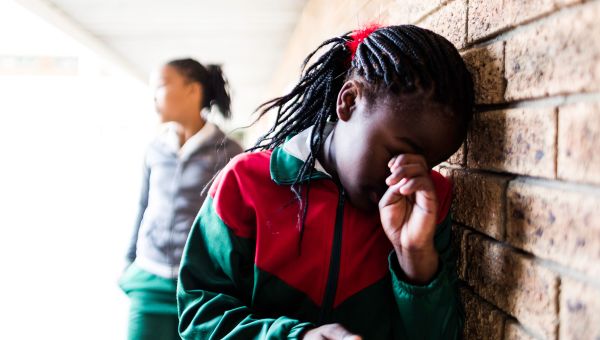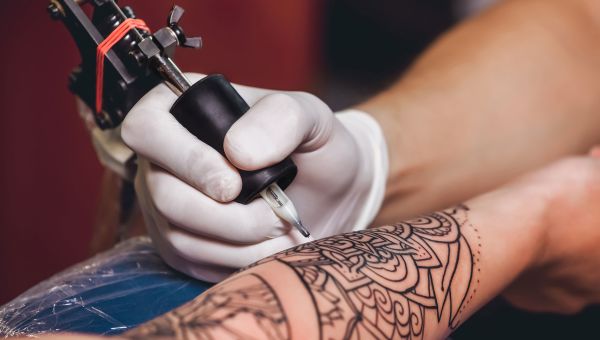Self-harm among teens is on the rise–here’s why
Learn who may be at risk and how to spot the warning signs.
Updated on January 8, 2025

While trying to cope with emotional pain or discomfort, some teens and young adults turn to non-suicidal self-injury (NSSI)—like cutting, burning, self-hitting, or scratching—to manage these difficult or overwhelming feelings.
“Those who engage in NSSIs are seeking a way to calm themselves, or to cope with negative emotions,” says Allison Kress, Psy.D., a clinical psychologist in Seattle, Washington, and leading expert in cutting and self-injury.
Dr. Kress says self-injury is very common and appears to be on the rise. About 17 percent of adolescents have self-harmed at some point. Kress cautions that if it isn’t properly addressed, the practice can sometimes escalate, and in some cases, continue into adulthood.

Learn to recognize those at risk
NSSIs affects all genders, ethnicities, ages, and sexual orientations. Research also suggests that college students are at the same risk level or possibly even more at risk, with 17 to 35 percent of college kids engaging in self-harm. And while boys may not always self-harm in the same ways as girls (who primarily cut themselves), they may do so in other ways, such as bruising themselves, substance use-related harm, or having others harm them.
Those who identify as lesbian, gay, bisexual, transgender, or queer may not have a strong support system and may be grappling with their sexual orientation or experiencing some form of bullying, which increases the risk of self-harm. According to the Trevor Project, up to 54 percent of LGBTQ teens between age 13 and 17 self-harmed in the last year. Native/Indigenous LGBTQ youth self-harmed at an even higher rate of 67 percent.
“Social media has taken bullying to an entirely different level and has led to less interpersonal communication,” she says. “As a result, teens often feel isolated, and don’t know how to navigate the stresses of social media.”
Other risk factors for self-harm include having friends who self-injure, low self-esteem, difficulty communicating, a history of emotional problems, anxiety, impulsive behavior, or being victims of physical, sexual, or emotional abuse or neglect.
“Self-harm can become a primary coping mechanism,” Kress says. “The problem is the relief is usually short-lived and has the possibility of escalating if a person doesn’t learn how to regulate their emotions.”

Seek treatment to identify triggers and cope
Most who engage in self-harm feel isolated and alone, and Kress says while they may want to stop cutting and perhaps have even tried to end the behavior on their own, they don’t always have the tools and support needed to be successful.
“Self-injury isn’t done to elicit attention,” Kress says. “It occurs among those who lack problem-solving skills or have difficulty putting their feelings into words.”
To help with this, several therapeutic strategies are available. Cognitive behavioral therapy (CBT) can help identify unhealthy beliefs and reactions and develop new and more appropriate behaviors and beliefs to replace them. Therapies based around mindfulness can also help build healthy coping skills for dealing with difficult or negative thoughts and feelings.
Dialectical behavior therapy (DBT), which uses talk-based therapy to pinpoint and change negative thinking, regulate emotions, and master coping skills, is another appropriate treatment for those who engage in self-harm.
“The goal of DBT is to help clients identify what triggers their feelings of self-harm and to help them learn coping skills to feel better without harming themselves,” Kress says. “By changing the way they think or respond to a situation, they can change the way they feel and prevent relapses later in life.”

Don’t overlook the underlying cause of self-harm
Psychotherapy treatments like CBT and DBT are used to break the self-destructive cycle of self-injury, while also identifying underlying health issues that need to be addressed.
“Cutting is a symptom, not the primary issue causing them to engage in self-harm,” Kress says. “Just treating the cutting is like putting a bandage on the problem. It’s important to also determine what’s going on below the surface, and whether a person is also suffering from anxiety, depression, bipolar disorder, or an eating disorder.”
Kress says it’s also imperative that clients identify their triggers for self-harm and develop new coping strategies. While everyone has different triggers, Kress says common examples of triggers that can lead to self-harm include being bullied, abuse, and fighting with family or friends. Use of drugs or alcohol may also raise the risk that someone could engage in self-injury.
There are no medicines specifically for treating self-harming behavior. However, in cases where a mental health condition is diagnosed alongside the self-injuring behavior, medications such as antidepressants may be prescribed.

Boost endorphins to help with recovery
The act of cutting may release endorphins in the brain, creating a sense of calm and helping the body deal with pain and stress, says Kress. An addictive behavior, it can also prove dangerous, causing excessive blood loss, permanent scars, infections, and sometimes life-threatening injuries.
Depending on why someone self-harms, there are replacement behaviors that may help in the short term. For example, if someone self-harms because it helps them feel less numb, then holding an ice cube or clapping your hands may help. If it helps release anger, then ripping paper, flattening a soda can, or scribbling in red ink may be good substitutes.
In the longer term, it can help to learn healthy coping mechanisms. “In therapy, clients are taught coping skills and ways to boost endorphins naturally, replacing self-harm behavior with healthy activities such as exercise, journaling, spending time with friends, or listening to music,” says Kress. “Without mastering alternative coping skills, self-harm can continue into adulthood and lead to increased depression and anxiety.”
Kress says that emphasizing healthy behaviors, including eating well, getting enough sleep, and engaging in regular exercise, can help to deter the urge to engage in self-harm and prevent relapses.

Be aware of relapses
Without therapy, teens who self-harm are at a higher risk of suicide and may become adults who use self-injury as a coping mechanism, says Petra Steinbuchel, MD, medical director for Mental Health and Child Development at UCSF Benioff Children’s Hospital in Oakland, California.
“Scars on their body can lead to guilt and retrigger the issues that led to them cutting in the first place,” she says. “It’s important for people with NSSIs to learn how to ask for what they need so they don’t resort to cutting.”
Dr. Steinbuchel says many teens and adults may believe they have their NSSIs under control, only to find themselves relapse.
“Setbacks aren’t uncommon,” she says. “A major life event, such as the death of a loved one or feeling emotionally overwhelmed, are situations that might lead to a relapse.”
And while relapses can be frustrating, Steinbuchel advises not to look at them as a sign of failure, but rather that you might need additional support, or to revisit therapy.

Families can provide support
Family-centered treatment is often used when working with children and teens who engage in self-injury.
“It can be difficult for families to understand why their loved one is harming themselves,” says Shelly Nakaishi, a nurse practitioner in the Department of Psychiatry at UCSF Benioff Children’s Hospital in Oakland, California.
“Rather than saying something like, ‘What’s wrong with you?’ we encourage them to say, ‘It sounds like you are in a lot of pain,’ and encourage them to talk about it, if their child chooses to do so.”
Telling a family member to quit cutting cold turkey is unrealistic. Instead, Nakaishi encourages parents and loved ones to formulate a plan which can include therapy as well as assessing whether their family member’s behavior is being done to cope with feelings, or whether their intention is to commit suicide, in which case they need immediate medical attention.

Moving past the scars and stigma
The scars associated with self-injury remain long after recovery from self-harm and often serve as a reminder of a painful past. Certain people choose to cover up their scars with clothing, while others search for a way to remove or fade their disfigurements.
“The scars can cause shame in some people and lead to body image issues as well as unwanted questions,” Steinbuchel says. “Some choose to get tattoos to cover the scars, while others find success using scar reduction creams or getting procedures such as laser resurfacing.”
Treatments for scars depend on their severity and where they are on a person’s body. Some have found relief in using makeup, while others have turned to surgical procedures such as skin grafts.
Steinbuchel says the decision on how to handle scars is a personal one and often depends on whether people feel comfortable sharing their story.

Cornell University. What is self-injury? Accessed September 18, 2024.
Maureen Salamon. Cutting and self-harm: Why it happens and what to do. Harvard Health Publishing. May 31, 2023.
Mental Health America (MHA). Self-Injury (Cutting, Self-Harm Or Self-Mutilation). Accessed September 18, 2024.
Tori DeAngelis. Who self-injures? Monitor on Psychology. July/August 2015.
The Trevor Project. Self-Injury and its Relationship to Suicide Attempts Among LGBTQ Young People. October 9, 2023.
National Society for the Prevention of Cruelty to Children (NSPCC). Young people and self-harm. Accessed September 18, 2024.
McEvoy D, Brannigan R, et al. Risk and protective factors for self-harm in adolescents and young adults: An umbrella review of systematic reviews. J Psychiatr Res. 2023;168:353-380.
Mayo Clinic. Self-injury/cutting: Risk factors. April 6, 2023.
McKean A, Rahmandar MH. When Children and Teens Self-Harm. American Academy of Pediatrics. June 18, 2024.
The Trevor Project. Support for LGBTQ+ Self-Harm Recovery. August 21, 2021.
Nemours Children’s Health. Helping Teens Who Self-Harm. June 2022.
Nemours Children’s Health. How Can I Stop Cutting? August 2023.
Gunnarsson NV. The scarred body: A personal reflection of self-injury scars. Qualitative Social Work. 2023;21(1), 37-52.
More On


video

article

slideshow


video


video
